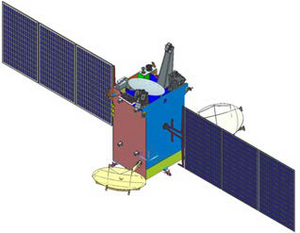Engineering:GSAT-19
 Render of GSAT-19 | |
| Mission type | Communications |
|---|---|
| Operator | INSAT |
| COSPAR ID | 2017-031A |
| SATCAT no. | 42747 |
| Website | GSAT-19 |
| Mission duration | Planned: 10 years[1] Elapsed: 7 years, 1 month, 13 days |
| Spacecraft properties | |
| Bus | I-3K |
| Manufacturer | ISRO Satellite Centre Space Applications Centre |
| Launch mass | 3,136 kg (6,914 lb)[1] |
| Dry mass | 1,394 kg (3,073 lb)[1] |
| Dimensions | 2.0 × 1.77 × 3.1 m (6.6 × 5.8 × 10.2 ft)[1] |
| Power | 4,500 watts[1] |
| Start of mission | |
| Launch date | 5 June 2017, 11:58 UTC[2] |
| Rocket | GSLV Mark III-D1[3] |
| Launch site | Satish Dhawan SLP |
| Contractor | ISRO |
| Orbital parameters | |
| Reference system | Geocentric |
| Regime | Geostationary |
| Longitude | 48° E[4] |
| Perigee altitude | 35,470 km (22,040 mi) |
| Apogee altitude | 35,869 km (22,288 mi) |
| Inclination | 0.101 deg |
| Period | 23 hr, 50 min, 10 sec |
| Epoch | 10 June 2017, 02:29 UTC[5] |
| Transponders | |
| Band |
|
| Coverage area | India |
GSAT-19 is an Indian communications satellite launched by the Indian Space Research Organisation aboard a GSLV Mark III on 5 June 2017.[2]
Satellite and payloads
The satellite will act as a testbed for the modular I-6K satellite bus, carrying experimental technologies such as ion thrusters for manoeuvring and stabilisation, active thermal control using thermal radiators, a miniaturised inertial reference unit, indigenously produced lithium-ion batteries, and C-band traveling-wave-tube amplifiers.[6][7][8]
Rather than traditional transponders, GSAT-19 carries four Ku/Ka-band forward link beams and four Ku/Ka-band return link beams, providing much higher data throughput than India's previous communications satellites.[9][10] It additionally carries a Geostationary Radiation Spectrometer (GRASP) payload, which will "monitor and study the nature of charged particles and the influence of space radiation on satellites and their electronic components".[11]
Orbit raising and station keeping
The satellite was launched aboard the GSLV Mk III-D1 rocket in the evening of 5 June 2017 to a geostationary transfer orbit perigee of 180 km (112 mi). This was followed by a series of orbit raising operations (using an on-board LAM and chemical thrusters[1]) to place the satellite in the intended geostationary orbital slot.
| Op # | Date/ Time (UTC) |
LAM burn time | Height achieved | Inclination achieved |
Orbital period | References | |
|---|---|---|---|---|---|---|---|
| Apogee | Perigee | ||||||
| 1 | 6 June 2017 08:33 |
116 s | 35,938 km (22,331 mi) | 172.77 km (107.35 mi) | 21.56° | 10 h, 30 min | [12] |
| 2 | 7 June 2017 10:14 |
5538 s | 35,840 km (22,270 mi) | 10,287 km (6,392 mi) | 7.02° | 13 h, 58 min | [13] |
| 3 | 9 June 2017 04:25 |
3469 s | 35,875 km (22,292 mi) | 30,208 km (18,770 mi) | 0.793° | 21 h, 38 min | [14] |
| 4 | 10 June 2017 02:29 |
488 s | 35,869 km (22,288 mi) | 35,470 km (22,040 mi) | 0.101° | 23 h, 50 min, 10 s | [5] |
References
- ↑ Jump up to: 1.0 1.1 1.2 1.3 1.4 1.5 "GSLV Mark III-D1 / GSAT-19 Mission". Indian Space Research Organisation. http://www.isro.gov.in/sites/default/files/flipping_book/GSLV%20Mark%20III%20D1/files/assets/common/downloads/GSLV%20Mark%20III%20D1.pdf.
- ↑ Jump up to: 2.0 2.1 Clark, Stephen (5 June 2017). "India's launcher fleet gets an upgrade with successful test flight". Spaceflight Now. https://spaceflightnow.com/2017/06/05/indias-launcher-fleet-gets-an-upgrade-with-successful-test-flight/.
- ↑ Laxmi Ajai, Prasannal (19 May 2017). "Come June 5, ISRO to launch 'game changer' rocket". The Times of India. Times News Network. http://timesofindia.indiatimes.com/india/isro-all-set-for-indias-most-powerful-launch-vehicle/articleshow/58754518.cms.
- ↑ "Delivered Communication and Navigation Payloads". ISRO/Space Applications Centre. http://www.sac.gov.in/Vyom/dpp.jsp.
- ↑ Jump up to: 5.0 5.1 "The fourth and final orbit raising operation...". Indian Space Research Organisation. 10 June 2017. http://isro.gov.in/update/10-jun-2017/fourth-and-final-orbit-raising-operation-of-gsat-19-satellite-has-been.
- ↑ "Annual Report: 2014-2015". Indian Space Research Organisation. 2015. p. 26. http://www.isro.gov.in/sites/default/files/pdf/AR2014-15.pdf.
- ↑ "First Prototype of ISRO's Semi-Cryogenic Engine To Be Ready By 2016". AA Me, IN. 19 August 2015. http://www.aame.in/2015/08/first-prototype-of-isro-semi-cryogenic.html.
- ↑ "GSat 19". Gunter's Space Page. http://space.skyrocket.de/doc_sdat/gsat-19.htm.
- ↑ "Isro's GSAT-19, GSAT-11 satellites: Game changers in communications". The Times of India. Press Trust of India. 5 June 2017. http://timesofindia.indiatimes.com/india/isros-gsat-19-11-satellites-a-revolution-in-communications/articleshow/58983052.cms.
- ↑ Graham, William (5 June 2017). "GLSV Mark III rocket conducts 'all-up' launch with GSAT-19 satellite". NASASpaceFlight.com. https://www.nasaspaceflight.com/2017/06/glsv-mark-iii-rocket-launch-gsat-19-satellite/.
- ↑ Ramachandran, R. (26 June 2017). "ISRO's Mk III Launched a Little-Known Instrument Called GRASP – This Is What It Does". The Wire. https://thewire.in/151354/grasp-isro-mk3-radiation-gsat-20/.
- ↑ "The first orbit raising operation...". Indian Space Research Organisation. 8 June 2017. http://isro.gov.in/update/08-jun-2017/first-orbit-raising-operation-of-gsat-19-satellite-has-been-successfully-carried.
- ↑ "The second orbit raising operation...". Indian Space Research Organisation. 8 June 2017. http://isro.gov.in/update/08-jun-2017/second-orbit-raising-operation-of-gsat-19-satellite-has-been-successfully-carried.
- ↑ "The third orbit raising operation...". Indian Space Research Organisation. 10 June 2017. http://isro.gov.in/update/10-jun-2017/third-orbit-raising-operation-of-gsat-19-satellite-has-been-successfully-carried.
 |


